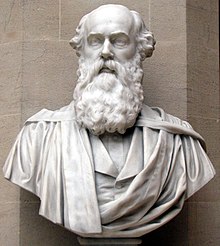Henry John Stephen Smith

Henry John Stephen Smith , often quoted by HJS Smith, (born November 2, 1826 in Dublin , † February 9, 1883 in Oxford ) was an English mathematician. His contributions to matrix theory as well as number theory were of lasting importance in mathematics. The Smith normal form of a matrix is named after him.
life and work
Smith was born the fourth child of barrister John Smith. His father died when Henry Smith was two years old. The family moved to England very soon after his father's death. Smith's mother taught Smith until he was eleven. At the age of 15 he was enrolled in Rugby School in Rugby, Warwickshire. His poor health forced the interruption of school, but he was able to successfully in Italy on a scholarship to Balliol College of University of Oxford prepare, where he began to study the 1845th His studies were also interrupted by illnesses; He caught malaria while on vacation in France, but used it to study at the Sorbonne and the College de France in Paris. In 1849 he graduated from Oxford with top grades in classical languages and mathematics. He became a fellow and tutor at Balliol College. In 1860 he became a professor on the Savilian Chair of Geometry at Oxford University . For financial reasons, he continued to teach at Balliol College until his appointment as a Fellow of Corpus Christi College removed him.
Smith is best known for his work on number theory, in which English mathematicians were rarely active in the 19th century. His greatest mathematical influence were the related writings of Carl Friedrich Gauß . Smith proved that any natural number can be represented as the sum of five and seven squares, and also gave a general method of determining the number of possible representations of a natural number by k squares ( The orders and genera of quadratic forms containing more than three indeterminates , Proceedings Royal Society 1867). It may be related to the relative isolation of English mathematics in this area that these results went largely unnoticed on the continent and were even the subject of the great mathematics prize of the Paris Academy in 1882. In order not to embarrass the academy, Smith, who had previously written a protest note to Hermite , submitted his solution from 1867 as a prize work and won the prize together with Hermann Minkowski , but died before he could receive it.
Smith wrote an extensive report on the theory of numbers in 1865 , in which he summarized many of his own contributions. In an 1875 paper in the Proceedings of the London Mathematical Society, he also anticipated fractal sets such as the Sierpinski carpet and the Cantor set .
In 1868 he received the Steiner Prize in Berlin for work on geometry. In 1861 he was elected a Fellow of the Royal Society . From 1874 to 1876 he was President of the London Mathematical Society . In 1876 he became an Honorary Fellow of the Royal Society of Edinburgh . In 1880 he was accepted as a corresponding member of the Prussian Academy of Sciences .
Web links
- John J. O'Connor, Edmund F. Robertson : Henry John Stephen Smith. In: MacTutor History of Mathematics archive .
- Smith "On continued fractions," Messenger of Mathematics 1874
- Alexander MacFarlane Ten British Mathematicians of the 19. Century , with chapter on Smith
Individual evidence
- ^ Fellows Directory. Biographical Index: Former RSE Fellows 1783–2002. (PDF file) Royal Society of Edinburgh, accessed April 8, 2020 .
| personal data | |
|---|---|
| SURNAME | Smith, Henry John Stephen |
| ALTERNATIVE NAMES | Smith, HJS |
| BRIEF DESCRIPTION | English mathematician |
| DATE OF BIRTH | November 2, 1826 |
| PLACE OF BIRTH | Dublin , Ireland |
| DATE OF DEATH | February 9, 1883 |
| Place of death | Oxford , England |